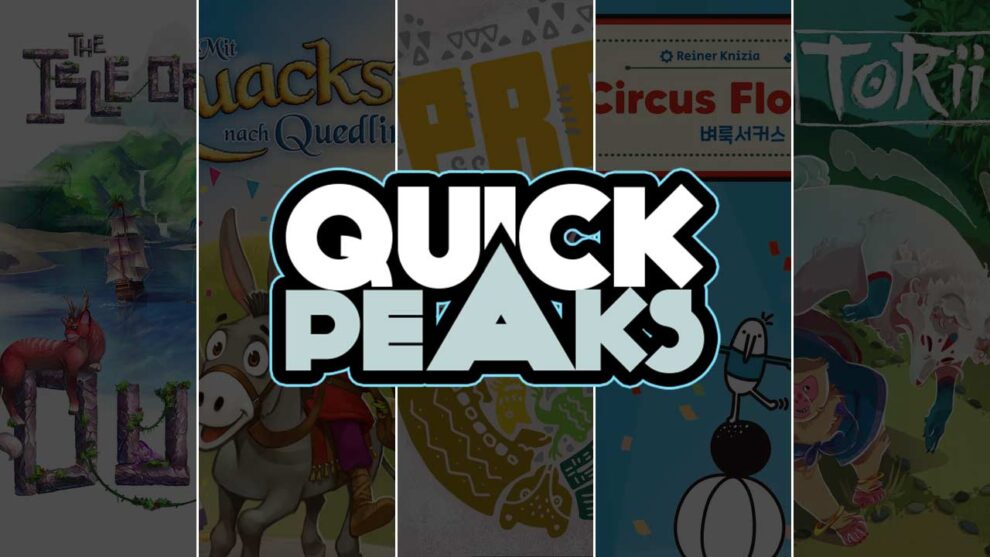Isle of Cats Duel – K. David Ladage
There are games that do not really need a two-player adaptation because they play very well at that count. Then there are games that cannot be played at all with two players and, if a couple is going to enjoy the game, it needs one. Isle of Cats falls into the middle of this spectrum: it is a game that can be played at two players, but that player count will not deliver the best experience (to be honest, the base game plays at two players better in the Family mode than the Normal mode).
The Duel version of the game is excellent! It plays very well, offers some good decision space without being a heavy game. My wife and I were able to get into the play quickly, and everything we knew of the original aided in our introduction to this trimmed down version. We might find ourselves playing this more than the original, as good as that is.
If I have a complaint, it would be that the game plays in four rounds, but the mechanic to keep track of those four rounds does not use the ship token and movement as it is handled in the base game. The method used is serviceable (three cat tiles set aside and returned to the bag at the end of each round), but not nearly as thematic.
Ease of entry?:
★★★★★ – No sweat
Would I play it again?:
★★★★★ – Will definitely play it again
Read more articles from K. David Ladage.
Quacks & Co.: Quedlinburg Dash – David McMillan
Quacks & Co.: Quedlinburg Dash is a bag-building game (in the vein of its namesake) that has the players racing along a track to try to reach the riches at its end before their opponents can. In true bag-building style, each player starts with a few tokens that are all the same. But, as the game goes on, the players will be purchasing different tokens with different powers to add to the bag, differentiating them from their opponents.
While The Quacks of Quedlinburg prominently featured a push-your-luck mechanic, this version of the game has been significantly altered to make it suitable for a much younger audience…and very successfully so. After sitting down to play the game with my son for the first time several days ago, he has been clamoring to play it over and over ever since. And, I find I don’t mind that at all. Quacks & Co.: Quedlinburg Dash is just as much fun for adults as it is for kids, and that’s saying a lot!
Ease of entry?:
★★★★★ – No sweat
Would I play it again?:
★★★★★ – Will definitely play it again
Read more articles from David McMillan.
Prey – Andrew Lynch
There are two wrinkles to Prey, a small-box trick-taker from designer TORU II and publisher Allplay:
- At the beginning of each hand, every player rolls two dice. The values shown on those dice represent your two possible bids. If I were to roll a 2 and a 5, for example, I have to win exactly either two or five tricks to score a point at the end of the hand.
- Every card has two values on it, one representing the Predator and one representing the Prey. For the first half of each 12-trick hand, players use the Predator values. Halfway through the hand, you turn your hand upside down, which shifts the values of your cards by six in one direction or the other.
Stripping players of the agency to make their own bids is kinda fun. Knowing that low numbers become high and high numbers become low halfway through the hand makes navigating a seemingly impossible roll into a somewhat satisfying little puzzle.
Though Prey never took off in any of my plays, I think it’s a good introduction to the world of weird trick-takers. With a low price point ($10) and gorgeous art from Sai Beppu, it invites players in. More than that, trick-taking games with bidding can seem impenetrable to new players. Prey almost serves as training wheels, making that decision for you. The question instead becomes, can you figure out how to make that happen? You probably can’t. That’s okay. Such is the nature of the animal world.
Ease of entry?:
★★★★★ – No sweat
Would I play it again?:
★★☆☆☆ – Would play again but would rather play something else
Circus Flohcati – Andy Matthews
Back in 2016, publisher Grail Games ran a Kickstarter for a card game called Circus Flohcati. It was still early in my board game journey and I was taken by the colorful artwork and interesting illustrations…and more importantly I didn’t know who Reiner Knizia was. I backed the game, and then promptly never played it—a story we’ve all heard before.
Fast forward to 2 weeks ago, after my return from my trip to Essen SPIEL, and imagine my surprise to find a copy of Circus Flohcati waiting on my doorstep. This is a new version from Korean publisher Playte, distributed by 25th Century Games. And this time I was ready; light card games are my super power, and Reiner Knizia has become one of my favorite designers.
In Circus Flohcati players attempt to score the most points by collecting high value cards in their hand, by forming “trios” of same value cards (10 points for three ones, three twos, etc), or by “throwing a gala” (earning 10 points and ending the game). The game has a bit of push your luck—as you flip over cards from the shared deck you’re hoping to see either high value cards or a card that you already have two of (so that you can form a trio). But watch out because if you reveal a card whose color is already visible then your turn is over. The cardplay is simple and fun, but the meta game is even better…trying to remember who is collecting what numbers, and how many they might have. If you’re a fan of light card games, then get this one to your table quick!
Ease of entry?:
★★★★★ – No sweat
Would I play it again?:
★★★★★ – Will definitely play it again
Read more articles from Andy Matthews.
Torii – Tom Franklin
You’ll move your player token, 1-3 squares at a time, around a 4×4 grid, leaving Followers in your wake. Get four of them in a row, and you’ll build a Torii, or a gate entrance over the Follower of your choosing and remove the rest from the board. Movement is complicated by not being able to land on (or count as a movement point) the row or column your opponent’s piece ends their turn in.
I’m often suspicious of games that include an “advanced” option with ways of breaking the standard rules in some way. I’ve found this frequently means the base game isn’t very good and the publishers decided to add things to make it more interesting. That’s definitely the case with Torii. I’m willing to play most games many times before making a judgment, but after two tries at Torri (one with, one without the advanced options) I knew I’d seen just about all the game had to offer.
Ease of entry?:
★★★☆☆ – There were a few questions
Would I play it again?:
★★☆☆☆ – Would play again but would rather play something else













